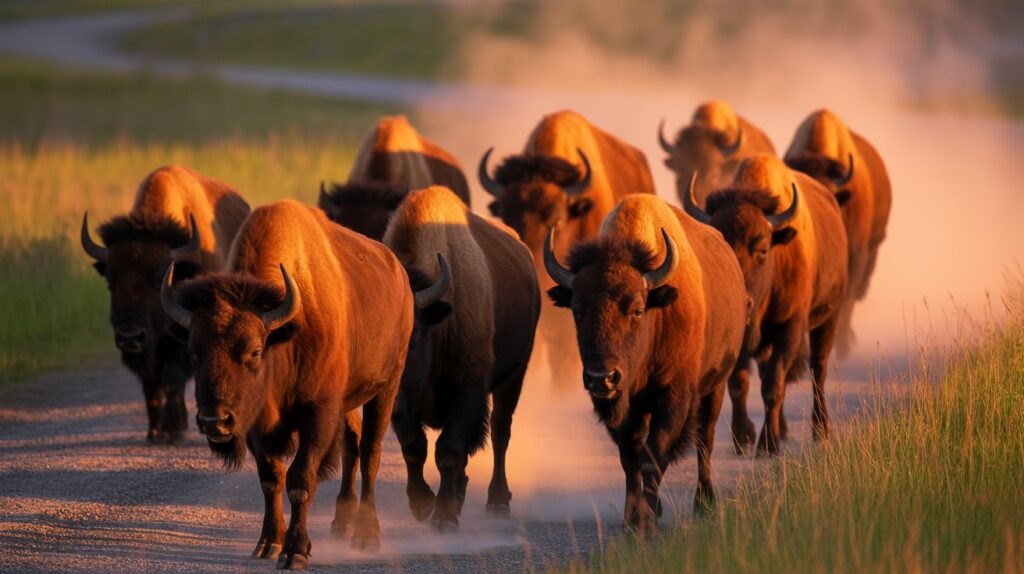Table of Contents
- Introduction: Yellowstone’s Porous Borders
- The Seasonal Exodus: A Natural Migration Cycle
- Key Animals on the Move
- The Iconic Bison Herds
- Majestic Elk Populations
- Apex Predators: Wolves and Grizzly Bears
- Why Do Animals Venture Beyond the Park?
- Challenges Outside Yellowstone’s Boundaries
- Conservation and Coexistence: Protecting Migratory Routes
- Conclusion: A Shared Landscape
- Frequently Asked Questions (FAQs)
Introduction: Yellowstone’s Porous Borders
Yellowstone National Park is a world-renowned sanctuary for North American wildlife. However, the park’s boundaries are invisible to the animals that call it home. The phenomenon of animals leaving Yellowstone is not a sign of a failing ecosystem but rather a testament to a healthy, dynamic one driven by ancient, instinctual patterns. This movement, primarily seasonal migration, is crucial for the survival of many species, yet it presents significant challenges for both the animals and the human communities on the park’s periphery. Understanding this exodus is key to ensuring the long-term health of one of America’s most treasured natural landscapes. 🏞️

The Seasonal Exodus: A Natural Migration Cycle
The primary reason animals leave Yellowstone is seasonal migration. This age-old rhythm is dictated by the changing seasons and the availability of resources.
- Winter’s Grip: As heavy snow blankets Yellowstone’s high-elevation plateaus, foraging becomes nearly impossible. The deep snowpack covers grasses and shrubs, forcing herbivores to seek lower elevations where the snow is shallower and food is more accessible. ❄️
- Spring’s Renewal: With the spring thaw, these animals reverse their journey. They follow the greening vegetation back up to the lush, nutrient-rich summer ranges within the park, where they give birth and raise their young.
This migratory pulse is the lifeblood of the Greater Yellowstone Ecosystem, a vast, interconnected landscape that extends far beyond the park’s official borders.
Key Animals on the Move
While many species migrate, a few iconic animals define the mass movements out of Yellowstone.
The Iconic Bison Herds
Yellowstone is home to the nation’s largest free-roaming bison population. During harsh winters, large numbers of bison migrate north into Montana’s Paradise and Gallatin Valleys and west toward Hebgen Lake. This movement is essential for their survival but often brings them into conflict with agricultural interests, primarily due to concerns about the transmission of brucellosis to cattle.
Majestic Elk Populations
Elk are perhaps the most famous of Yellowstone’s migrants. Tens of thousands of elk move from their summer ranges inside the park to wintering grounds at lower elevations. The Northern Range herd, for example, travels to areas north of the park, providing a critical food source for predators like wolves and a focal point for wildlife watchers.
Apex Predators: Wolves and Grizzly Bears
Following the herds of elk and bison are the apex predators. Wolves and grizzly bears do not recognize park boundaries. They follow their prey out of Yellowstone, which is essential for maintaining a balanced ecosystem. However, this movement increases the risk of encounters with humans and livestock, posing significant management challenges. 🐺🐻
Why Do Animals Venture Beyond the Park?
Beyond the primary driver of seasonal food availability, other factors contribute to animals leaving Yellowstone:
- Population Density: Healthy and growing wildlife populations can lead to increased competition for resources, pushing some animals to seek new territories.
- Habitat Exploration: Younger animals, in particular, may disperse from their birth areas to establish their own home ranges.
- Harsh Weather: Exceptionally severe winters can force more animals than usual to travel farther in search of sustenance.
Challenges Outside Yellowstone’s Boundaries
Life outside the protected confines of the park is fraught with danger. Migrating animals must navigate a landscape fragmented by human development.
- Habitat Loss: Private land development, roads, and fences can block ancient migratory routes.
- Human-Wildlife Conflict: Predators like wolves and grizzlies may prey on livestock, while herbivores like bison and elk can compete with cattle for grazing land.
- Hunting: While hunting is prohibited inside the park, many animals that migrate out become subject to state-managed hunting seasons, a contentious but vital wildlife management tool.
Conservation and Coexistence: Protecting Migratory Routes
Protecting the animals leaving Yellowstone requires a collaborative approach that extends across the entire Greater Yellowstone Ecosystem. Conservation groups, state and federal agencies, and private landowners are working together to:
- Secure conservation easements on private lands to protect critical winter ranges and migration corridors.
- Implement wildlife-friendly fencing that allows animals to pass through without injury.
- Promote conflict-reduction tools, such as range riders and livestock guardian dogs, to foster coexistence between predators and agriculture.
- Construct wildlife overpasses and underpasses to reduce vehicle collisions on busy highways.
Conclusion: A Shared Landscape
The movement of animals leaving Yellowstone is a powerful reminder that nature cannot be contained by lines on a map. This seasonal migration is a fundamental sign of a thriving ecosystem. Ensuring the future of these incredible journeys depends on a shared commitment to conservation, coexistence, and the stewardship of the entire landscape—both inside and outside the park. The survival of Yellowstone’s iconic wildlife hinges on our ability to protect the pathways that connect their world to ours.
Frequently Asked Questions (FAQs)
1. Why do bison leave Yellowstone in the winter? Bison leave Yellowstone during the winter to find food. Heavy snow at higher elevations covers their primary food source, grass, forcing them to migrate to lower-elevation valleys outside the park where snow is less deep and foraging is easier.
2. Are the animals leaving Yellowstone permanently? No, for most species, this is a seasonal migration. Animals like elk and bison leave for wintering grounds and return to the park in the spring and summer to breed and raise their young.
3. Is it dangerous for animals to leave the park? Yes, leaving the park exposes animals to numerous risks, including hunting, vehicle collisions, habitat fragmentation from development, and potential conflicts with livestock and humans.
4. What is being done to protect migrating animals? Conservation efforts include protecting land corridors through easements, building wildlife-friendly fences and highway crossings, and working with local communities to reduce human-wildlife conflicts.
